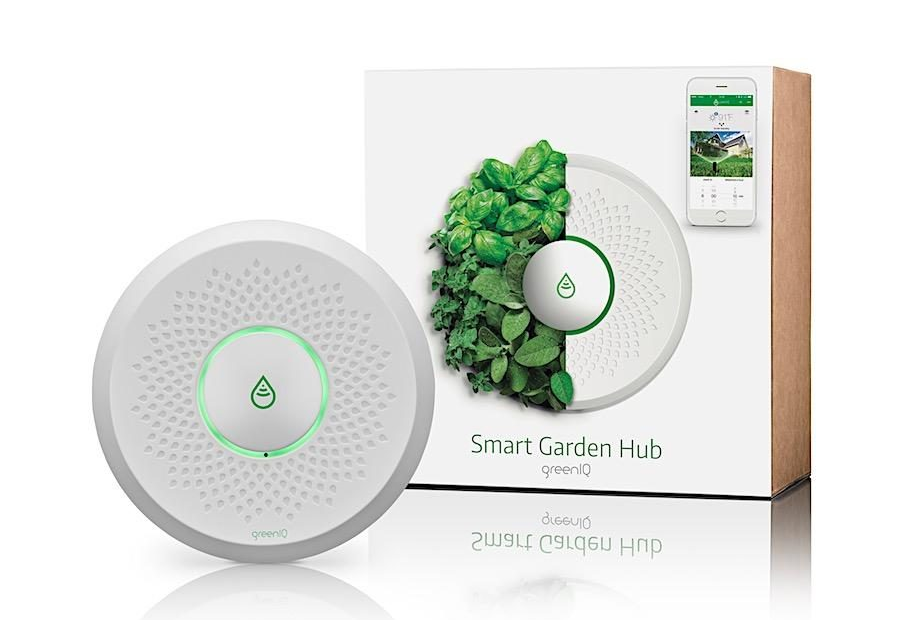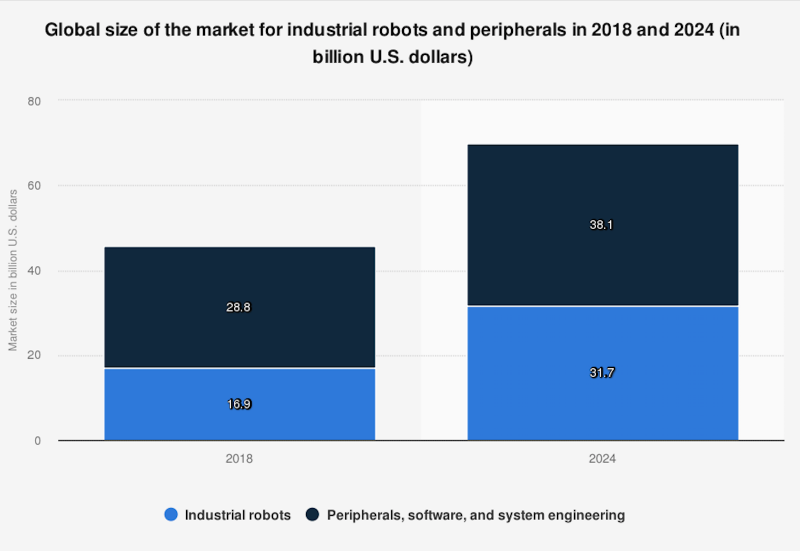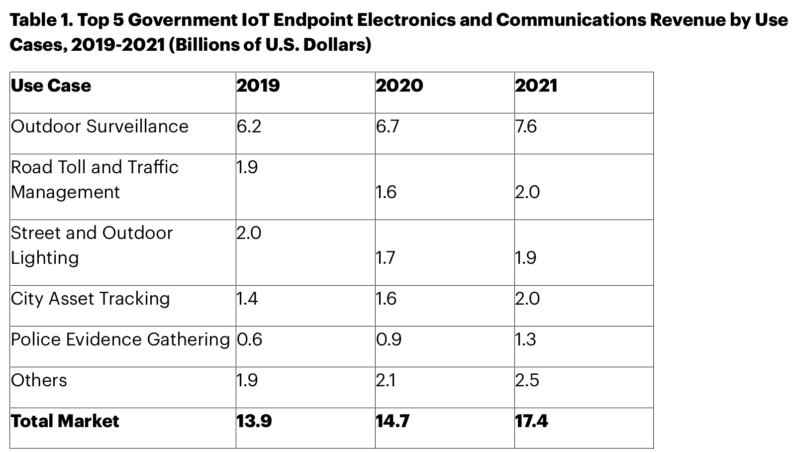The Internet of Things (IoT) is rapidly transforming businesses and entire industries by interconnecting physical objects and enabling real-time data collection and actionable insights. According to Statista, global IoT spending will surpass $1 trillion in 2024, underlining the growing appetite for IoT solutions.
As a data expert with over 10 years of experience in data extraction and analytics, I have conducted in-depth research on the top IoT applications and use cases that showcase the tremendous potential of IoT. In this comprehensive guide, I will explore over 30 real-world examples of organizations harnessing IoT to drive innovation, efficiency, and added value across their operations and offerings.
Optimizing Smart Factories
From manufacturing equipment to inventory control and energy use, IoT is making factories smarter and production processes highly optimized.
Enterprise Asset Management
Enterprise asset management utilizes IoT sensors and connectivity to track and manage physical assets across their lifecycle. Equipment, vehicles, facilities, inventory and more can be monitored in real-time to inform data-driven decisions:
- Operational efficiency jumps as asset visibility and utilization increases
- Preventative maintenance improves as sensor data predicts failures
- Inventory and warehouse management streamlines through asset tracking
- Assets last longer thanks to optimized performance and longevity
IBM [1] found sensors can detect developing issues in assets weeks or months before failure, enabling cheaper preventative fixes versus costly downtime from breakdowns.
Predictive Maintenance
Predictive maintenance harnesses IoT equipment sensors and analytics to forecast needs before something fails. Monitoring health metrics and performance data enables proactive servicing to keep machinery running smoothly.
For example, robotics firm Fanuc [2] uses sensors to track vibration, temperature, lubrication levels, and other IoT data points. Analyzing this data spots degradation signs and predicts impending failures. Proactive repairs avoid disruptions.
Industrial Process Optimization
Connecting production systems and machines via IoT allows manufacturers to monitor processes in real-time. This visibility enables them to analyze workflows, pinpoint inefficiencies, and use data to optimize and automate operations.
According to Research and Markets [3], the global industrial robotics market will balloon to $73 billion by 2023, driven by demand for automation and process optimization using IoT-enabled robots.
Optimized processes reduce labor costs, minimize waste and downtime, improve quality control, and increase production volume and speed.
Energy Management
With energy costs fluctuating and efficiency regulations tightening, manufacturers deploy IoT solutions to monitor and reduce energy consumption.
Smart meters and sensors enable real-time tracking of equipment-level usage. Analytics help identify waste, schedule production during off-peak times, and adjust equipment settings to drive efficiency.
According to WebNMS [4], their IoT energy management system helped manufacturers cut energy usage 20-30%. Trimmed energy bills and smaller carbon footprints resulted.
Building Smarter Cities
IoT has become integral infrastructure as cities pursue efficiency, sustainability, safety, and livability goals. Applications span traffic control, environmental monitoring, public safety, and more.
Per Gartner [5], government IoT spending will hit $15 billion annually by 2023, with top applications:
Let‘s explore examples of smart city IoT deployments:
Outdoor Surveillance
IoT-connected cameras with computer vision analytics automate video monitoring across cities. Real-time hazard alerts enable quicker emergency response. But appropriate policies are critical to prevent misuse of surveillance data.
Smart Lighting
Networked LED street lights allow cities to control brightness remotely, identify failures quickly, and enable lighting to adapt based on environmental conditions, cutting electricity usage up to 80%.
Traffic Management
Sensors monitor real-time traffic flows and conditions. This data optimizes traffic light timing to coordinate signals and ease congestion. Route guidance apps also leverage traffic IoT data.
Smart Parking
In-ground parking sensors identify available spaces and feed occupancy data to apps guiding drivers to open spots faster. Smart parking improves utilization and access.
Structural Health Monitoring
IoT sensors track vibrations, tilts, and other metrics across infrastructure like bridges, railways, and tunnels. This facilitates proactive issue detection and maintenance before failures occur.
Smarter Water Management
IoT enables intelligent monitoring and control of water networks, treatment, usage and conservation.
Water Leakage Management
Sensors across the water network identify leaks and pipe bursts early to enable rapid response, minimizing water loss.
Water Quality Monitoring
IoT water quality sensors monitor reservoirs and pipes continuously for contaminants and abnormalities, safeguarding health.
Smart Irrigation
IoT soil moisture sensors help water landscapes more efficiently by using real-time data to deliver the precise irrigation needed, preventing overwatering.
For instance, GreenIQ [6] offers a sprinkler sensor that optimizes watering based on soil dryness. This avoids waste while keeping lawns and gardens lush.
Revolutionizing Healthcare with IoT
From remote patient monitoring to medical asset tracking, IoT is driving healthcare advances through enhanced care delivery, operational efficiency, and data insights.
Wearable Health Tracking
IoT-enabled wearable devices like smartwatches continuously measure the wearer‘s activity levels, heart rate, sleep patterns and more, powering fitness and wellness apps.
Global smartwatch shipments grew 24% year-over-year in Q1 2022 to reach 15.3 million units according to Counterpoint Research [7]. Top brands include Apple, Samsung, and Garmin.
Medical Asset Management
Hospitals use real-time location tracking via IoT to monitor medical equipment utilization and prevent misplacement or theft of high-value assets.
Remote Patient Monitoring
Doctors remotely monitor outpatients‘ vitals and health via connected wearables and at-home IoT devices. This enables timely interventions and reduces hospital visits.
Market researchers predict the remote patient monitoring market will experience 19.5% CAGR from 2022-2030, reaching $175 billion globally as healthcare systems adopt remote care capabilities. [8]
Innovating Retail with IoT
IoT provides retailers unmatched visibility into inventory, assets, consumers, and operations – powering optimization.
Smart Supply Chains
IoT asset trackers monitor supply chain status end-to-end in real-time: location, temperature, humidity, handling, etc. This boosts efficiency and transparency.
Automated Inventory Management
IoT sensors on shelves track product stock levels, turnover, and placement. This data optimizes ordering, merchandising, and loss prevention.
In-Store Analytics
In-store sensors provide customer traffic analytics to improve layout, promotions, and operations. Video cameras track dwell time at shelves. Spatial analytics map customer movement.
Consulting firm McKinsey estimates in-store analytics can boost operating margins 10-30%. [9]
Enhancing Workplace Efficiency with IoT
The workplace is growing smarter thanks to IoT-enabled security, space utilization and environmental monitoring, robots, and more.
Smart HVAC & Lighting
IoT sensors track occupancy, air quality, noise, temperature, and lighting levels across facilities. Facility managers use this data to optimize working conditions proactively.
Improved Space Utilization
Networked occupancy sensors measure workspace and conference room utilization over time. Facility managers leverage this data to optimize office layouts and space planning.
Assistive Robots
Office robots outfitted with IoT sensors autonomously navigate spaces to handle repetitive tasks like mail delivery. This boosts productivity by freeing up employee time.
Global shipments of service robots grew 37% in 2021 to exceed 583,000 units, reports the International Federation of Robotics [10]. Applications like office assistants remain top growth drivers.
The IoT Enabled Smart Home
IoT allows homeowners to remotely monitor, control, and automate home systems for comfort, security, and efficiency.
Smart Climate Control
Connected IoT thermostats and AC units can be controlled and scheduled via apps, optimizing temperature and airflow while users are away or sleeping.
Smart Lighting
Networked lightbulbs, switches and fixtures enable remote control and automation based on schedules or presence detection for convenience and energy savings.
Water Leak Detection
IoT moisture sensors identify pipe leaks, floods, or other water incidents quickly to avoid property damage. Smart water shutoff valves trigger automatically.
Smart Locks
Homeowners can remotely monitor and control IoT-enabled door locks via smartphone apps for convenient, keyless entry and enhanced security.
Revolutionizing Logistics & Transportation
From warehouses to trucks, planes, and container ships, IoT is helping track assets while providing operators greater visibility into conditions.
Fleet Management & Tracking
GPS asset trackers and onboard IoT sensors enable real-time fleet monitoring, including location, diagnostics, utilization patterns and more. This drives optimization.
Cold Chain Monitoring
IoT temperature sensors ensure perishable goods stay within safe ranges throughout transit and storage by triggering alerts for handling issues or deviations.
Warehouse Analytics
Sensors across warehouse operations drive data-based efficiency improvements in inventory handling, storage capacity, equipment usage, layouts, and labor allocation.
Autonomous Trucking
The autonomous trucking market swelled from $2 billion in 2021 to a projected $3 billion in 2024, reflecting rising investment. [11] IoT lidar, radar and camera sensors enable truck automation.
Mercedes Benz, Waymo, TuSimple, Embark and others aim to launch autonomous semi-trucks within the next five years. IoT is key enabler.
Energy Grid Modernization
Utility companies are deploying IoT to upgrade energy infrastructure monitoring and management through smart meters, predictive maintenance, and real-time analytics.
Smart Meters and Billing
IoT-enabled smart meters allow granular tracking of household-level electric, gas, and water usage. This empowers usage-based billing and conservation incentives.
Reduced Downtime
Sensors on grid infrastructure like transformers enable condition monitoring, predicting failures before outages occur. This shrinks restoration time.
Optimized Renewable Integration
IoT weather sensors paired with advanced grid analytics optimize renewable energy production forecasting and infrastructure planning as grids add more solar/wind.
The global smart grid market is projected to grow steadily at a CAGR of 18% from 2022-2027, topping $140 billion as grids modernize. [12]
Digital Twins Drive Insights
A digital twin is a virtual model of a physical asset or process, enabled by IoT sensor data. Digital twins unlock insights via monitoring, simulation, and optimization.
Product Development
Manufacturers create digital twins of new products to simulate performance across various conditions, accelerating design improvements.
Infrastructure Management
IoT sensors on bridges or rail systems feed digital twin models to detect structural issues early for proactive maintenance.
Smart Factories
Factories implement digital twins of production lines. Mirroring physical line status and output via IoT data helps optimize manufacturing.
IDC forecasts over 50% of Global 2000 companies will implement digital twins by 2026. [13] The market is estimated to reach $117 billion by 2028. [14]
The Future of IoT is Here
This overview of 30+ real-world IoT use cases merely scratches the surface of connected technology‘s vast potential. As platforms and devices grow more sophisticated, IoT adoption is accelerating across industries.
With infinite possibilities, Internet of Things applications will profoundly transform how organizations operate, compete, and serve customers while impacting our daily lives. However, challenges remain around security, privacy, integration, talent, and sustainable development which must be overcome to fully materialize IoT‘s promise.
I hope these IoT examples provide valuable insights into potential applications relevant to your organization. Please don‘t hesitate to reach out if you have any other questions!



